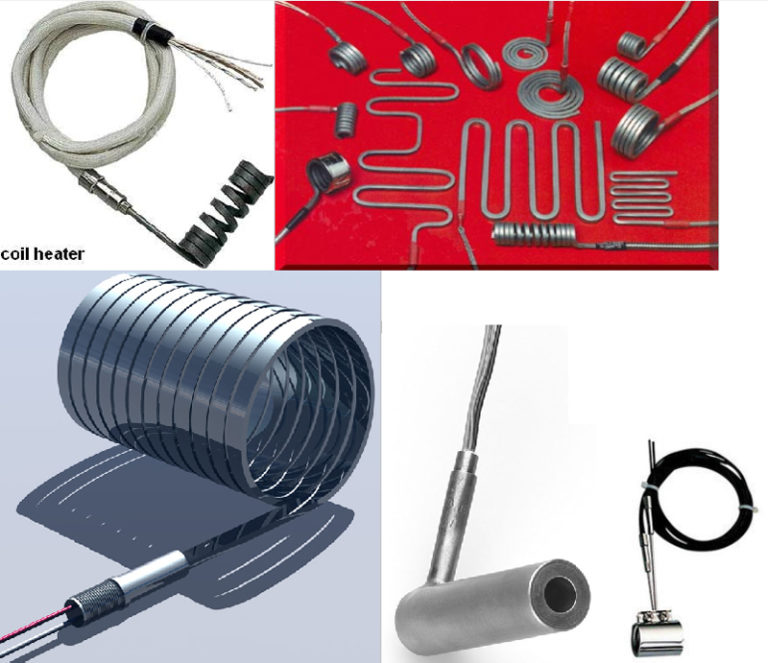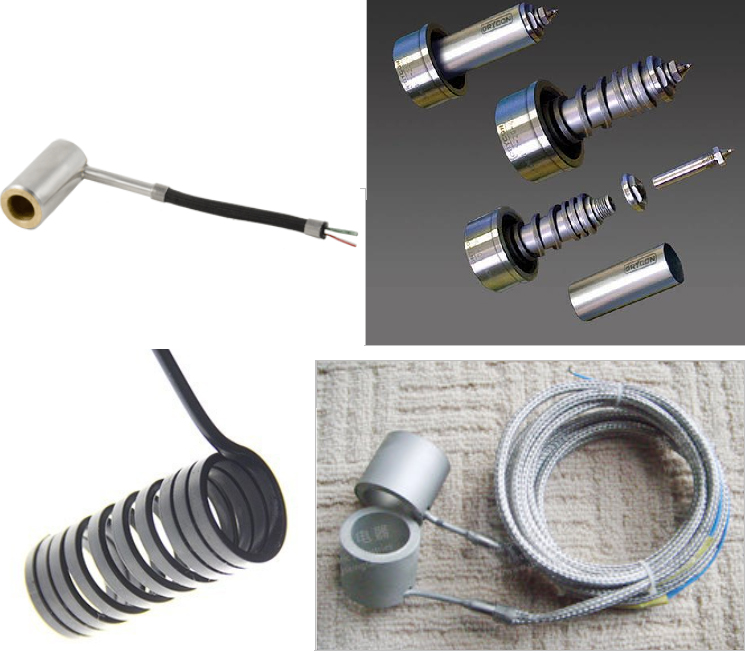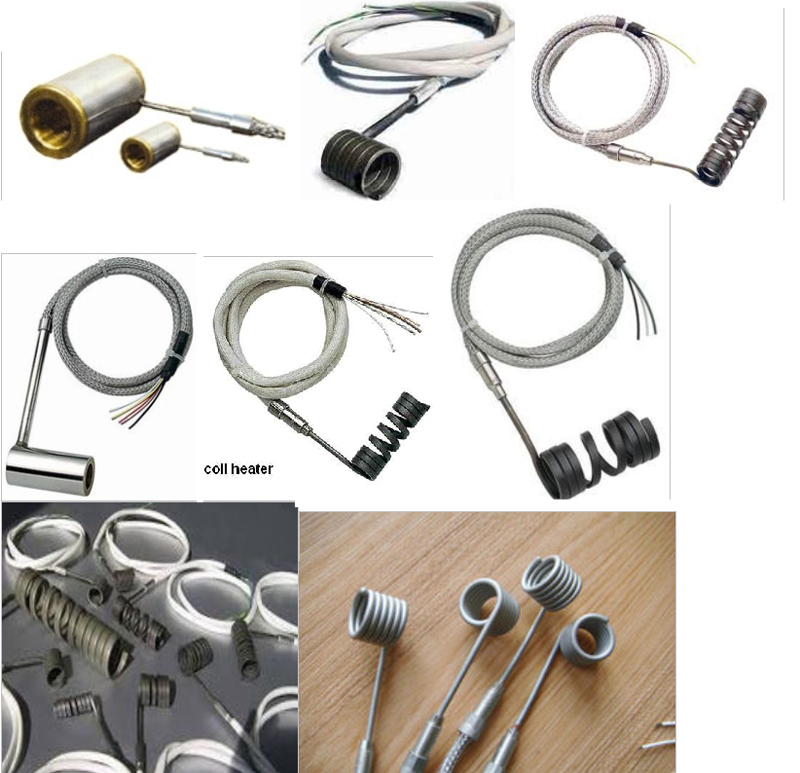PRESSURE TRANSMITTERS – STAINLESS STEEL PRESSURE TRANSMITTERS
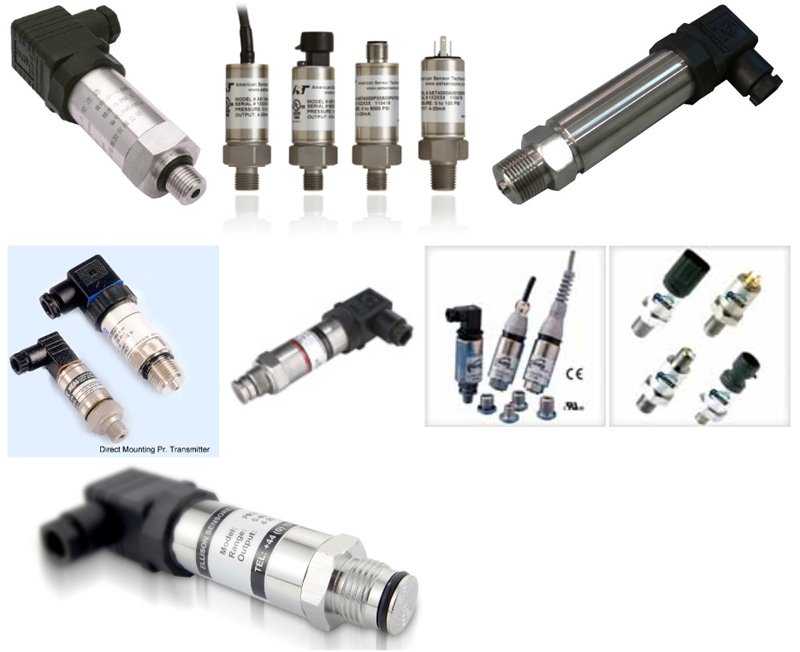
- 1/2% accuracy
- stainless wetted parts
- two wire 4…20mA
The Stainless Steel Pressure transmitter features compact construction, an integral amplifier, 2-wire 4-20mA output signal and extensive medium compatablility.The design of the Stainless Steel Pressure Transmitter provides a 1/2% accurate, low cost transmitter that can operate over a wide temperature range with corrosion resistance.The Stainless Steel Pressure Transmitter is available from stock in both standard and refrigerant models.
PRESSURE CONTROLLER
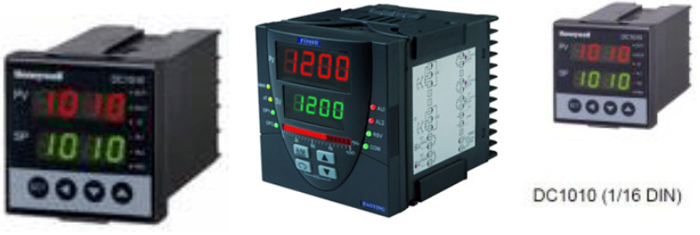
FEATURES
Easy to configure
Two different configuration levels provide easy access to parameters. A 4-digit security code prevents unauthorized changes. Parameters can also be hidden to the user to prevent mis-configuration of the unit.
Various Control algorithms
These series of controllers provide several different algorithms:⦁ PID or ON/OFF control.⦁ Heat/Cool algorithms with 2 different PID sets.
Dual display and Bargraph
Two large 4 digits displays and one 10 LED bargraph display PV, SP and configuration parameters. Up to 8 LEDs display the status of the different Outputs (Control, Alarm, …) and also provides indication of the Auto/Manual and Programmer states.
Setpoint Programming< strong>Extended Alarm capability
Three different alarm outputs are available per instrument, 17 alarm modes are configurable.
Autotuning capability
RS232 or RS485 ASCII protocol is optionally available. Up to 30 Controllers can be connected to a single host computer. The host computer can change the SP, monitor the PV, the output or change the configuration of the unit.
Remote Setpoint capability.
Manual / Automatic modes.
Universal Power supply
Operates on any voltage from 85Vac to 265Vac at 50/60Hz.
Large operating range
These instruments can operate from –20°C to +65°C (-4°F~149°F)
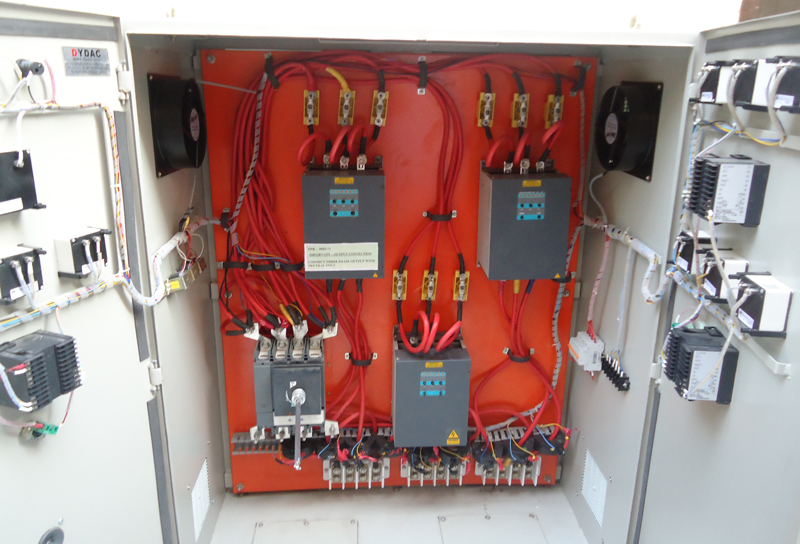
Panel housing the Thyristor Drive controlling the power of the heater to match the thermal requirements of the system for high accuracy control. The Control Panel also contains necessary control and safety features.
PID Cont. – Proportional, Derivative, Integral Three Term Indicating
The Panel Housing Dydac Thyristor Power Controller for controlling the Heater Controller for accurate control oftemperature or viscosity.
TE – The temperature sensor can be a theromcouple, resistance thermometer with or without a transmitter head.
VE – The control parameter maybe viscosity in lieu of temperature.The signal maybe milli-Volt (Thermocouple), Ohms (Resistance Thermometer) or Analogue eg 4-20mA (with transmitter head). PID Cont.
Thyristor Panel
Dydac Controls offers a wide range of both standard and custom engineered SCR power panels. From 100 watts to 500 KW’s , Dydac Controls can build an SCR system to meet your needs.Dydac Controls ’ standard line of SCR power control panels are engineered with safety and ease of installation in mind. The control panels are prewired and tested on name plate voltage. Customer needs only to install incoming power wires, outgoing heater wires and thermocouple input connections. Standard panel sizes are 20, 30, 60, 100, 150, 200, 250, 350 and 400 Amps. 230 to 480VAC.
Standard features include:
- SCR Power Controller – Single or Three Phase; Phase Angle Fired or Zero Voltage Switched
- NEMA 12 enclosure. Fan cooled or air conditioned
- Input power circuit breaker or fused disconnect with door interlock
- Definite purpose power contactor in front of SCR
- Power On-Off Button
- Manual reset button
- Power on indication (lamp)
- Load branch fusing with box style connections to the heaters
- Temperature controller. Separate over temperature controller
Options include:
- Power monitoring (volts, amperes )
- Chart recorder ( On Demand )
- Heater on indicator (lamp)
- Alarm indicators (lamps)
- Annunciation flashing beacon and/or audible horn
- Thermocouple outlet(s)
Dydac Controls uses Athena, Honeywell, Omron, Fuji, Axis, temperature controllers.
Standard SCR Power Control Panels
Dydac Controls panels are engineered and built for safety, strength and reliability in real world industrial environments. The system shown has these standard features:
- Dydac Controls “1000 or 3000 ” Series SCR
- Digital temperature controller
- Dedicated over temperature limit
- Manual reset button
- Load branch fusing
- Circuit breaker w/lockout handle
- NEMA 12 enclosure w/fan kit
Remember, you will need air inlet and outlet holes with fan cooling.Finally, plastic enclosures act as an insulator. You will most likely destroy an SCR control if you install it inside a plastic box. The only reliable way to use a plastic enclosure is to have a “thru-hole mounting” style heat sink, with the heat sink’s cooling fans outside of the box.
| Transformer coupled loads. Primary driving. Inductive heater loads. | Inductive loads. | Phase Angle Fired with Soft Start option. Current limit option. | Used with transformer-coupled heater loads to drive low voltage elements. |
Power Calculation
When selecting the correct sized SCR power controller, rate the SCR for at least 110% of the heater load. Heaters and power lines have tolerances that can swing on any given day or location.
Single Phase
WATTS÷ VOLTS= AMPS
Example: 18,000W ÷ 240V = 75A
AMPS x VOLTS= Watts
Example: 60Ax 480V = 28,800W
3-Phase
WATTS÷ VOLTS÷ 1.73 = AMPS
Example: 18,000W ÷ 240V = 75 ÷ 1.73 = 43.35 A
AMPS x VOLTS x 1.73 = Watts
Example: 60A x 480V x 1.73 = 49,824W
DYDAC TEMPERATURE AND POWER CONTROL PANELS
We are expert in designing Heating control Panels that are widely used for various applications in heat control processes. These are provided with Temperature Controllers, PID Temperature Controllers within the system. The excellent design and fabrication increases the accuracy and infallibility.
Dydac brand control panels are designed and engineered to meet virtually every heating applications. Rating in size from 5KW to 500KW Control panel made from 14, 16 SWG CRCA sheet duly painted. All necessary component to be provided with the panels.
Following are some of the Panels are being Manufactured by us
- Temperature & Power control Panel for all Industries
- Heat Treatment furnace SCR control Panel
- Furnace Temperature control
- Oven Temperature Control Panel
- Extruder Temperature Control Panel
- Melt Pressure Indicator Panel
- Melt Pressure Control Panel
Ceramic Infrared Heaters – Specifications
Ceramic infrared heaters are 96% infrared energy efficient. Uses for electric infrared heat can be found in many industries and applications and can be grouped into four major categories:
a. Curing
b. Drying
c. Heating
Within each of these major categories are literally hundreds of specific applications, and the list keeps growing as technology develops.
Our ceramic infrared heaters (emitters) are manufactured with three basic emitter faces: Concave, Flat and Convex. These emitter face styles will result in the specific radiant emission pattern as shown in our Ceramic Infrared Emitters Technical Manual. The concave surface will emit a “concentrated” radiant pattern which is highly effective when zone heating is desired as well as radiant heating in general. Flat surface emitters will produce a “uniform” pattern for even heating at a close proximity between the emitter and the target being heated. Finally, the convex shaped emitter gives off a “wide area”
pattern which is desirable in comfort heating or other applications that require a dispersed radiant emission pattern.
These heaters are durable, splash-proof and have a non-corrosive finish. Maximum temperature output of up to 1292*F (700*C).

TUBULAR HEATER FOR MANIFOLDS AND HOT PLATES / BLOCKS
Tubular Heaters are generally Formed to specified sizes in Hot Runner Manifolds and Hot Plates. these heaters are mainly used for Hot Runner manifolds and Hot Plates .We offer Tubular Heaters for superior performance and life expectancy to withstand high sheath temperature and provide the best combination of physical strength, high emissivity & good thermal conductivity to heat hot runner manifolds and Hot Plates.For manufacturing manifold tubular heaters it is necessary to provide an accurate dimensional sketch showing all centre distances, bending radius and path.Formed Tubular Heaters is supplied in Chrome Nickel Steel with nominal sheath diameter of 6 mm, 6.5 mm and 8.00mm Standard elements have a threaded terminal post which gives a cold section of approx 40mm minimum.For manufacturing manifold tubular heaters it is necessary to provide an accurate dimensional sketch showing all centre distances, bending radius and path.
How To Order
Please send a detailed dimensional drawing file showing all center distances along with
• Total path length
• Wattage
• Voltage
• Required quantity
TUBULAR HEATERS: FOR MANIFOLDS AND HOT PLATES – APPLICATIONS
TUBULAR HEATERS: FOR MANIFOLDS AND HOT PLATES – TECHNICAL DATA
| Length | 300 -1550mm | 400 – 2100mm |
| Maximum Current | 12 A | 15 A |
| Nominal Voltage | < 230V | < 400V |
| Wattage | ±10% | ±10% |
| Dielectric Strength | 1.5 HV | 1.5 HV |
| Insulation MΩ | >5Ω | >5Ω |
| Leakage Current | < 0.5 mA | < 0.5 mA |
| Minimum Unheated | 40mm | 45mm |
| Terminal Pins | M3 x .50mm/ Plain | M4 x .70mm |
LENGTH TOLERANCES – ± 2 %
DIAMETER TOLERENCE – ± 0.10 mm
What is a Cartridge Heater?
A cartridge heater is a device that is usually tubular and is inserted into drilled holes of metal blocks for heating.
Cartridge Heater Selection
The key questions which need to be answered before selecting a cartridge heater are:
- How much wattage is required?
- What voltage will be used?
- What is the heated length required?
- How long do the heater leads need to be?
- What is the diameter required?
- What is maximum temperature?
- What is the ambient temperature?
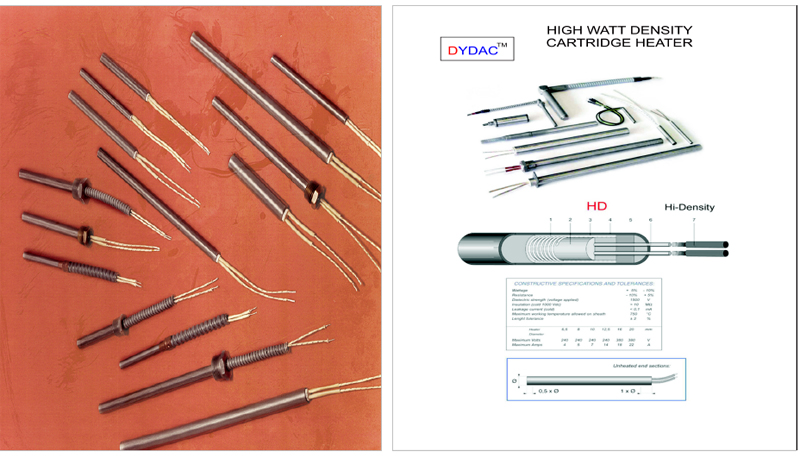
Application Of Cartridge Heaters
The majority of applications do not require maximum watt/in². Use a watt density only as high as needed. Take advantage of the safety margin provided by using ratings less than the maximum allowed. Select space heaters for most even heat pattern rather than the highest possible wattage per heater.
Hi-Density Cartridge Heaters
Hi-Density Heaters provide localized heating in processes requiring close temperature control such as:
- Dies
- Molds
- Hot stamping
- Packaging equipment
- Plastic extruders
- Injection molding mach.
- Platens
- Labeling
- Bag sealing
- Medical equipment
Maximum Temperature:
932°F (500°C).
Hi-Density Cartridge Heaters Metric Diameters
Standard Sizes and Ratings by Diameter
6.5mm, 8 mm, 10 mm, 11.5mm, 11.8mm, 12.5 mm, 16 mm, 18.5 mm, 19.5 mm, 20 mm
Other Sizes can be also made as per specifications
Temperature Controllers and Sensors for Cartridge Heaters
The sensor for the temperature control is also an important factor and should be placed between the working surface of the part and the heaters. The temperature of the part approximately 1/2″ away from the heaters is used in selecting maximum allowable Watt density from the graph.Control of power is an important consideration in high Watt density applications. On-off control is frequently utilized, but it can cause wide excursions in the temperature of the heater and working parts. Thyristor power controls are valuable in extending the life of high Watt density heaters, since they effectively eliminate on-off cycling.There are a variety of temperature controllers and sensors one can use depending on the application. One of the more popular sensor types for cartride heater applications are the surface mount temperature sensors. Thermocouple, RTD or Thermistors are available with an adhesive backing or the ability to be cemented to the surface being heated. There also bolt on and magnetic surface mount type temperature sensors available. Digital temperature controllers come in many different sizes with many output and input choices. Thermcouple and RTD inputs are the most popular with a dc pulse output. DC pulse ouputs allow the user to go to a larger relay to switch the heater load and use proportional control versus on/off control which can shorten the heater life.
Important Installation Considerations
1. For closest fit and best heat transfer, use reamed holes.
2. When possible, drill holes through the object being heated. This will make heater removal easier.
3. When using an anti-seize coating like Copper Graphite paste, do not apply over lead wires or any other current carrying conductors.
4. When using insulated tape or sleeving, check to make sure they are rated for the temperature of the application. Lower temperature rated materials can contain an adhesive or binder that can carbonize and become electrically conductive.
5. When using heaters near their maximum recommended watt density, it is recommended the temperature sensing probes be approximately 1/2″ from the heater sheath.
6. Lead wires should not be located in the hole containing the cartridge heater during operation. This may cause the lead wires to be exposed to temperatures above their rated temperature.
7. Many applications will subject a heater’s electrical terminations to one or more of the following potentially damaging conditions:
• Moisture
• Flexing
• Oil and other contaminants
• Abrasion
• High temperature
Note: To protect the heater from damage in these harsh environments, Dydac has a wide selection of terminations and options available.
Recommendations for Improving the life of Dydac High Watt Density Cartridge Heaters
Dydac Hi-Density Cartridge Heaters have been widely used in many demanding and diverse applications during the past quarter century. The most common applications are platen, plastic mold and die heating, liquid immersion and air heating. Selection of the wrong termination for the particular application is the major reason for all heater failures. However, failure to consider other important criteria can also have a negative effect on the life of the heater. To get the best performance and assure long life, it is important to carefully evaluate the following factors.
Heater Watt Density and Operating Temperature
Cartridge heater watt density is defined as the wattage dissipated per square inch of the heated sheath surface. For a particular application a heater’s watt density governs internal resistance wire temperature, which determines the outer sheath temperature. It is advisable to use heaters that have watt densities below the maximum recommended watt density for the material being heated to achieve the longest heater life. A Hi-Density cartridge heater designed at the maximum recommended watt density allows the smallest heater to be used to obtain the required wattage with good service life. All things being equal, using a lower watt density heater will typically provide optimized service life.Determining FitWhen heating a platen, mold, die or hot runner probe with Hi-Density Cartridge Heaters inserted into drilled holes, fit is an important factor in determining the life expectancy of the heater.
Temperature Control and Location of Temperature Sensing Device
In order to better control the heater temperature and hence the resistance wire temperature, use of an appropriate temperature control and the proximity of the heater to the sensor is very important. Higher watt density heaters can generate heat faster than the surrounding area’s ability to dissipate heat. This creates a thermal lag between the heater and the sensor. The closer the sensor to the heater, the better you can control the heater temperature. By keeping the sensor further from the heater, temperature gradients of several hundred degrees can be observed in many applications, especially during initial start-up and heavy thermal cycling. Although the set operating temperature may be low, the heater may be running at a very high temperature. This is a common cause of heater failure. This can be minimized using time proportional and PID functions of the temperature Controllers.
Temperature Control and Location of Temperature Sensing Device
In order to better control the heater temperature and hence the resistance wire temperature, use of an
Power Control
Power control methods affect the life expectancy of heating elements. In general, although economical, on-off controls increase thermal fatigue and oxidation rate on heating elements by causing wide temperature swings of the internal heating element. Silicone controlled rectifiers (SCR’s), and solid state power controls can increase the life expectancy of heating elements by reducing the temperature swings of the internal heating element.
Dydac Coil Heaters for Hot runner systems are manufactured with Premium Materials and under Tight Manufacturing controls. Also known as cable heaters or Hotrunner heaters, these heaters are an advance concept of thermal engineering which has a construction similar to high watt density cartridge heaters. With years of practical experience, Dydac Coil Heaters ensure Highest Quality standards to provide superior performance and better life expectancy at higher temperatures for many diversed applications such as Hot Runner moulds, manifolds & machine nozzles.

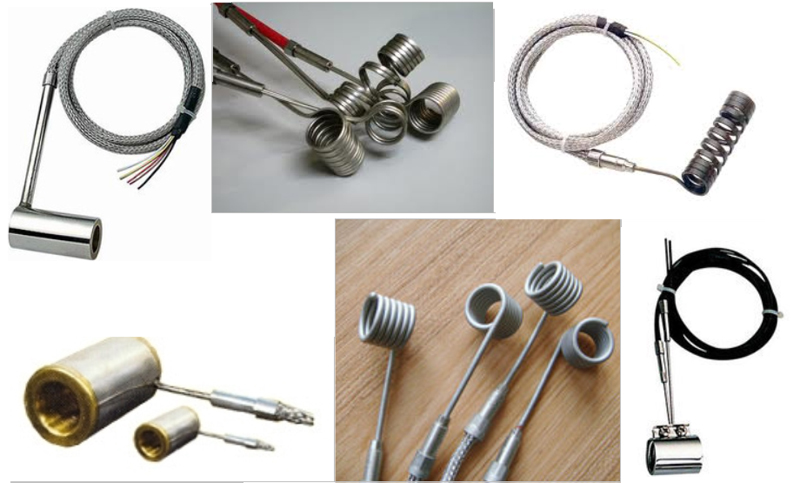
ADVANTAGES OF DYDAC COIL HEATER
- Standard sizes available with various cross section
- Coil Heaters with Various Watt Density options available
- Robust Design with Choice of Terminal Exits
- Coil heaters available with built in Thermocouple
- Designed for even heat profile
- Precision fit on Hot Runner
- Highly Non-corrosive
- Maximum heat transfer due to more contact area
- Advanced Thermal Engineering
COIL HEATER APPLICATIONS
- Hot Runner Nozzles & Bushings
- Hot runner Injection moulds
- Injection & Blow Moulding Machine Nozzles
- PET prefrom & Thin wall container Moulds
- Hot runner Manifolds
